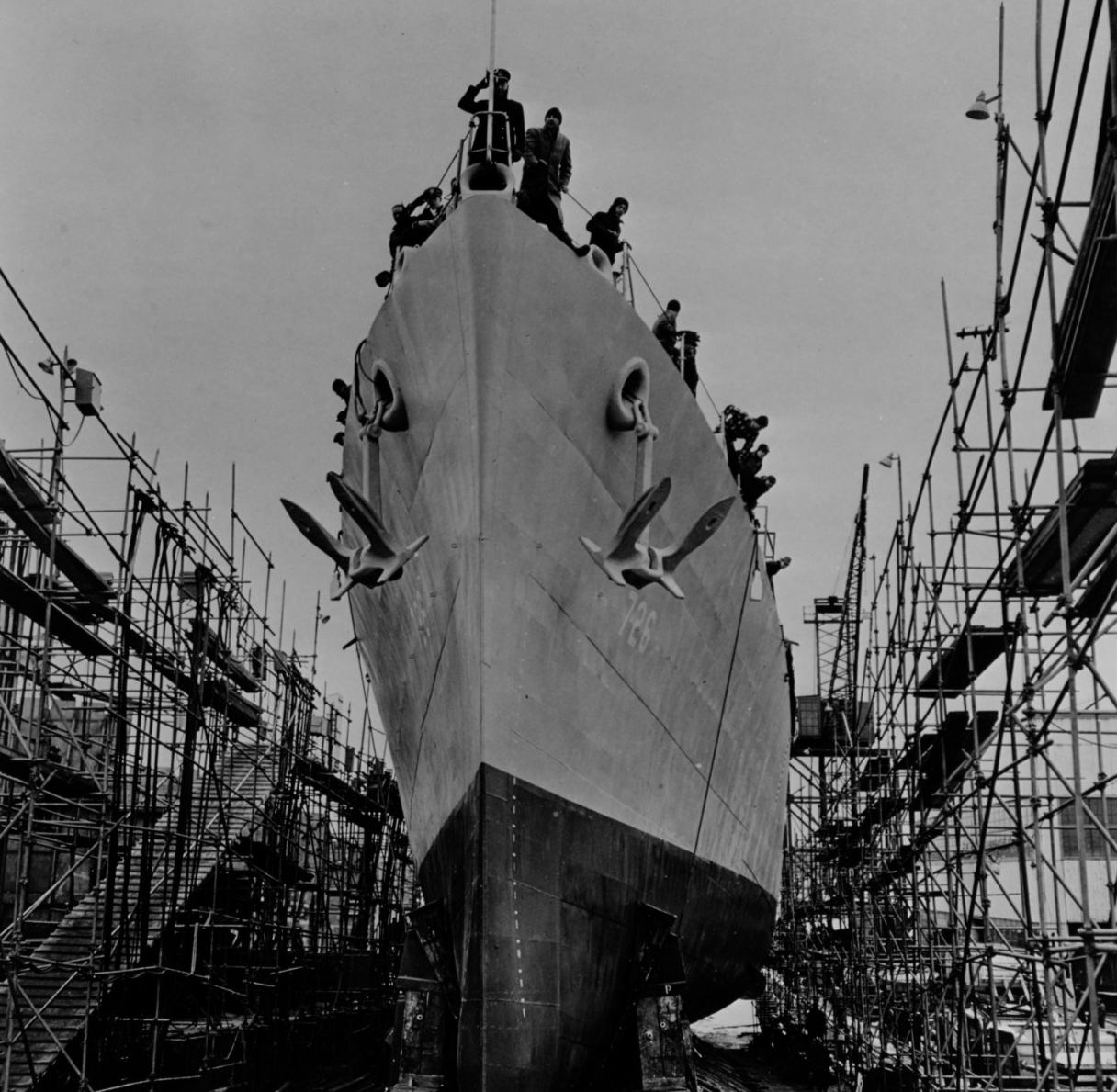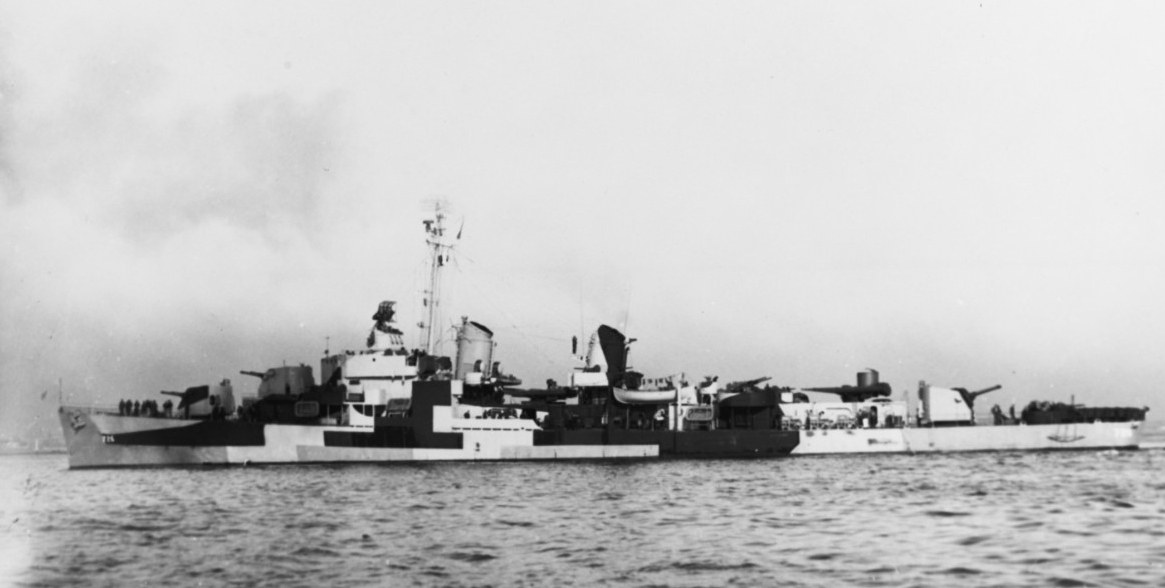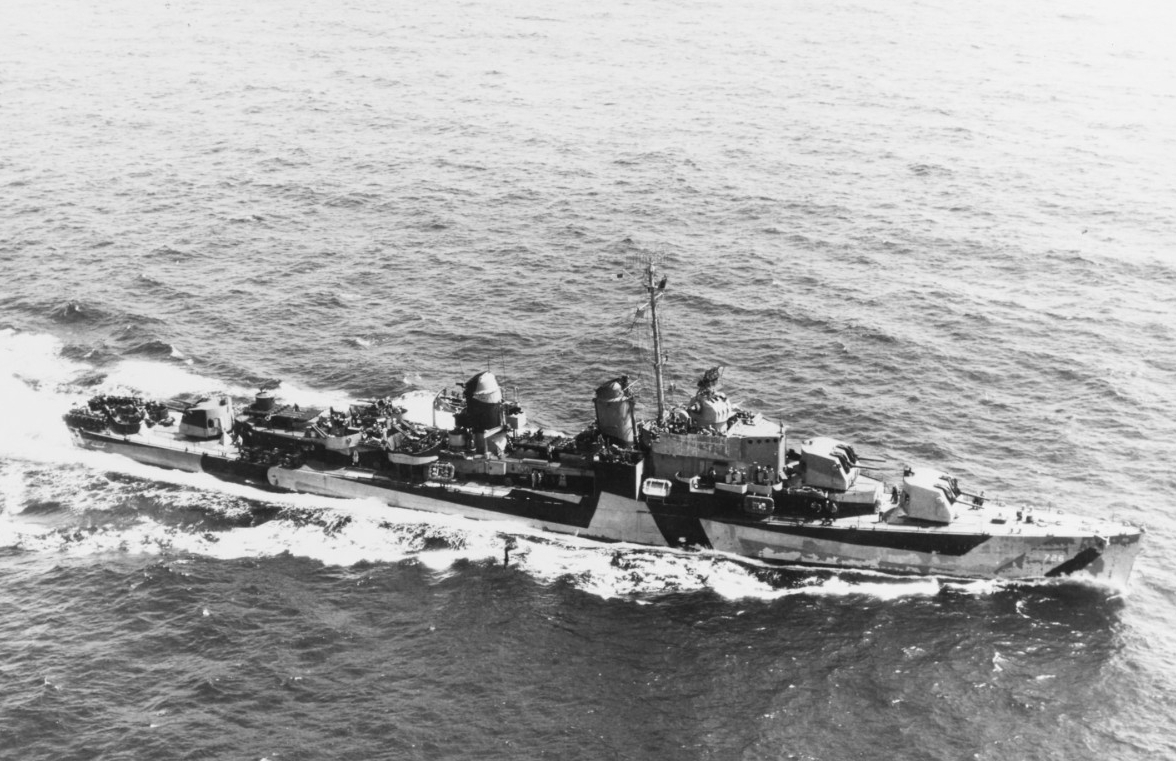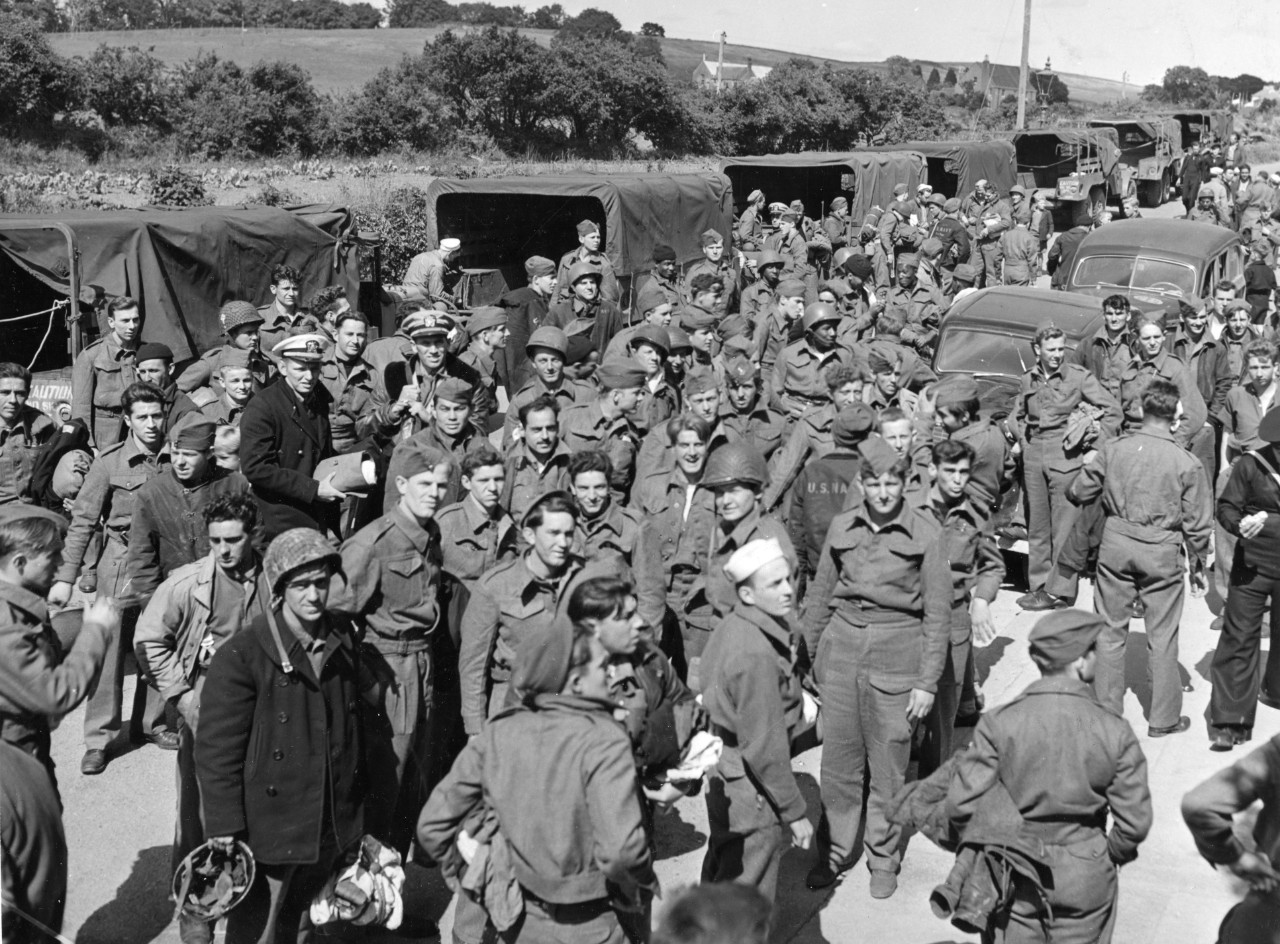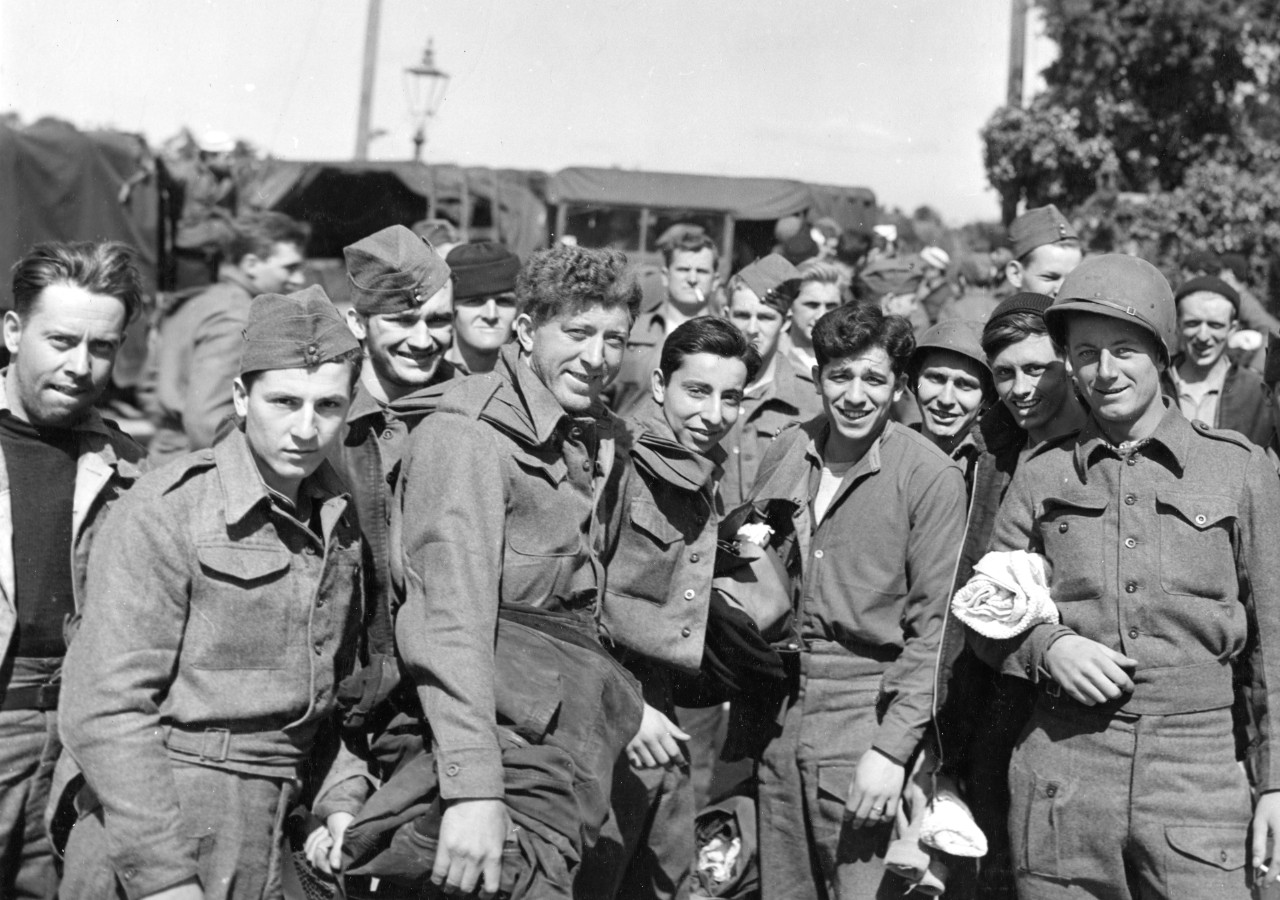Meredith III (DD-726)
1944
The third ship named for Sgt. Jonathan Meredith, USMC (circa 1772–7 August 1805). See Meredith I (Destroyer No. 165) for his biography.
III
(DD‑726: displacement 2,200; length 376'6"; beam 40'10"; draft 15'8"; speed 34 knots; complement 357; armament 6 5-inch, 12 40-millimeter, 11 20-millimeter, 10 21-inch torpedo tubes, 6 depth charge projectors, 2 depth charge tracks; class Allen M. Sumner)
The third Meredith (DD‑726) was laid down on 26 July 1943 at Bath, Maine, by Bath Iron Works Corp.; launched on 21 December 1943; and sponsored by Mrs. William Kopper.
The recruits earmarked to form the ship’s company completed their basic training at Naval Training Station Bainbridge at Port Deposit, Md. The men attended a variety of classes and drills to orient them to shipboard life, and to bring the officers and enlisted men to a physical peak, the station also inaugurated four week physical conditioning classes that included calisthenics and recreational sports.
Meredith was commissioned on 14 March 1944, at the Boston [Mass.] Navy Yard, Cmdr. George Knuepfer in command. Rear Adm. Robert A. Theobald, Commandant Boston Navy Yard and of the First Naval District, addressed the crew during the ship’s commissioning ceremony. Once the admiral departed from the ship that day, sailors lowered his flag and raised the commissioning pennant, and Meredith began her active service with Destroyer Division 119 of Destroyer Squadron 60. At times the division also comprised Allen M. Sumner-class sister ships Barton (DD-722), Laffey (DD-724), O’Brien (DD-725), and Walke (DD-723).
The newly commissioned warship spent a busy two weeks fitting out and carrying out an availability at the navy yard. The ship’s company familiarized themselves with Meredith as they held multiple ship’s drills, conducted degaussing calibration, radio direction finder calibration, radar calibration, and off Boston harbor magnetic compass calibration. Meredith held structural test firing and sonar tests off Cape Cod on the 30th, and the following day completed magnetic compass calibration, and radio, radio direction finder, and radar calibration off Boston harbor.
Meredith sailed on her shakedown cruise to the waters off Bermuda, and then accomplished further extensive training under the auspices of the Atlantic Fleet’s DD/DE Shakedown Group in early April 1944. The ship underwent a rigorous regimen which included an antisubmarine scenario with the “Attack teacher,” and a host of classes that included fire control alignment, fire control radar calibration, and battery check. The inspectors reported the ship’s “gunnery department to be in average condition, ordnance material maintenance was found to be quite good, especially in view of the heavy weather encountered en route to Bermuda.”
The destroyer turned toward World War II in European waters when she sailed from Boston as an escort in Convoy TCU-24B as the ships charted a course for Plymouth, England (8–27 May 1944). Cmdr. Knuepfer reported upon arriving at Plymouth and received his ship’s sealed orders for Operation Neptune—the Allied landings in the German-occupied Normandy region of France. Knuepfer and his staff attended a special briefing held in what he called the “Old Theatre” (most likely Plymouth’s famed Palace), where the briefers explained the ship’s role to them. Meredith and her consorts were to support the landings by the U.S. First Army’s VII Corps, Maj. Gen. J. Lawton Collins, USA, in command, which would land the 4th Infantry Division, Maj. Gen. Raymond O. Barton, USA, on Utah Beach along the Baie de la Seine. As part of the great endeavor, Knuepfer was to act as the Escort Commander for Convoy U-3, which would also be screened by four Coast Guard escort ships, French Flower class corvettes Aconit (J-1095) and La Renoncule, and a trio of British trawlers. These escorts were to shepherd 16 tank landing ships (LSTs) and six Rhino barges, carrying nearly 7,500 soldiers and their equipment.
The careful orchestration required to ensure that all of the Allied vessels of the vast assemblage reached their assigned target areas on time meant that Meredith and the ships of U-3 actually gathered and set out not from Plymouth but from Torquay, a small Devon seaside town just over half the distance from Plymouth to Exmouth (5–6 June 1944). The vessels of the convoy made their way via swept channels through minefields across the English Channel, but thrust into strong swells as a heavy overcast and moderate sea churned the water into froth. The tides in the channel, especially as they approached the French coast, averaged up to six knots at full flood, but the convoy’s slowest vessels ironically limited their speed to six knots. Knuepfer consequently found himself compelled to compensate by steering 86° off their base course in order to make good their progress, and the crew also repeatedly kept to their tight schedule by making radar navigational fixes.
At several tense points Knuepfer reported that the lookouts and bridge watchstanders saw “innumerable ships illuminated by star shells and snowflakes which indicated presence of E-boats [German fact attack craft, usually torpedo boats or motor torpedo boats] but none of them approached close enough to my convoy to entail any real danger and I felt that not to disclose our position was the wisest course.” The commanding officer further reflected upon crossing with the slow convoy as “the most hazardous of the trip.” Nonetheless, as Allied vessels passed in the crowded convoy routes they often signaled to each other, and a number of British ships wished Meredith variants of “good luck and happy hunting.”
Despite the tide and navigational issues, Meredith and her companions reached the transport area as assigned on time, and the destroyer turned over the convoy to the task force commander. Meredith detached to guard the ships anchored to the northeastern sectors of the transport area about five miles from the French coast, and together with five other destroyers patrolled the area for E-boats. The ship continued to ward the vulnerable transports and landing craft as they landed the assault troops on Utah Beach on D-Day, 6 June 1944.
At about 0600 the following day, on the 7th of June 1944, orders directed Meredith to Fire Support Station No. 2, about a mile and a half to two miles off the French coast, just to the eastward of the boat lane through which a steady stream of landing craft carried soldiers and sailors to the dearly won beachhead. Meredith fired her first shots in anger when she answered the calls of gun support fire parties, some Navy teams and some Army. At times Meredith operated slightly southwest of Grandcamps-les-Bains as the warship unleashed multiple salvoes of her 5-inch guns against German tank and troop concentrations attempting to contain the beachhead. Lt. Cmdr. Donald B. Amage, the ship’s executive officer, led the Combat Information Center (CIC) team and efficiently maintained the warship’s position and provided firing data to the gunners based on this information. It “was a gratifying thing,” Knuepfer reflected, “to hear when our salvo reached them, “well done, MEREDITH, you got them in the first salvo.”
The Allies attained victory and successfully landed ashore because of a number of reasons, one of which concerned their ships’ bombardment. Rear Adm. Alan G. Kirk, Commander, Western Naval Task Force, concluded in his report to Flt. Adm. Ernest J. King, Chief of Naval Operations, and Commander in Chief United States Fleet:
1. “That the naval gunfire plans were sound, realistic, and effectively carried out.”
2. “That the effect of naval gunfire on coast and beach defenses was a major factor in enabling the troops to land and start their advance inland.”
3. “That efficient air spot and deliberate fire over a long period are required to neutralize or destroy concrete batteries or strong points.”
Meredith pounded the enemy troops on the 7th until four minutes before midnight, when she received orders to proceed to the northward of the more heavily-armed battleships and cruisers in the gun support area and screen them against E-boats. The Germans prowled the area and just before Meredith reached the new station she received a report of E-boats concentrating in that area from the Cherbourg coast of the Cotentin Peninsula. The destroyer charted a course to the northward of a position just five miles from Îles Saint-Marcouf and began to patrol her station with about six other destroyers.
Despite the extensive minesweeping efforts, mines posed a deadly threat to ships in the area and Meredith properly set her degaussing coils. The sea was choppy with a fresh breeze blowing, and the sky low and overcast with a ceiling of about 1,000 feet. The moon emerged visibly from time-to-time through breaks in the clouds. Just over an hour and a half into the mid watch battleship Nevada (BB-36) bore 350° at a range of three miles from Meredith, heavy cruiser Quincy (CA-71) 030° and 1.7 miles, and Tuscaloosa (CA-37) 070° at 1.3 miles.
Suddenly at 0152 on Thursday 8 June 1944, Meredith struck a submerged mine amidships on the port side of her keel right under No. 2 fire room. Knuepfer described how the ship “gave a tremendous lurch forward and upward,” and the explosion threw everybody topside to their knees and drenched them with a huge cloud of water. None of the survivors could afterward recall seeing any flames or smoke in spite of the force of the blast, but debris hurtled through the air and scythed into crewmen. Meredith lost all communications and power and turned slowly to starboard as she drifted ominously to a stop, dead in the water. The mine’s blast wiped out No. 1 fire room, No. 1 engine room, and No. 2 engine room, killing most of the men in those compartments including many in the repair parties topside just above those rooms. The explosion blew a hole 65 feet outward in that area, and completely demolished the main deck and superstructure deck therein, half of No. 2 stack, the forward boat davit, and the motor whaleboat. The force of the detonation blew some of the engineering machinery overboard, and tangled much of the remainder. Meredith listed nearly 12° to starboard and appeared to be settling.
MMC Bryan B. Lawson led the 12 men in the No. 2 engine room (after engine room) watch section when the explosion stunned him and his fellow watchstanders. Despite being dazed by the blast, Lawson managed to make his way out of the shattered space by climbing out the hatch and out to the fantail. As the chief turned he did not see any of the other men escape from the damaged compartment, and realized they must still be trapped below. He obtained a flashlight and at great risk of his own life, went down into the totally dark and wrecked compartment. Lawson discovered water pouring in and rising to a depth of within four feet of the overhead, but bravely waded through the filthy and murky water and saved four men, passing them up the ladder to the hatch for other men to pull them out onto the deck. All four of the sailors sustained burns, lacerations, and fractures, and later required additional medical assistance back in England. For Lawson’s “total disregard for his own safety” he subsequently received the Navy Cross.
The bridge in the intervening time re-established communications with Repair I and instructed them to send a messenger to get in touch with Repair III. They in turn would pass on the captain’s orders to Lt. (j.g.) Edward S. Doe, the damage control officer, and Ens. Robert G. McElroy, his assistant damage control officer, to report on the extent of the damage and flooding. Doe took command of Repair III and McElroy of Repair I, and from the time of the explosion the two officers continued their untiring efforts to save the ship for over 32 hours. The torpedo officer, who stood watch on the bridge, lay aft to check the depth charges and returned to report that he verified they were set on “Safe.”
When the commanding officer gathered some men and they inspected the impact area, they discovered that despite the horrific damage the bulkheads on each side of the damaged area seemed to be intact and the bilges dry. The forward auxiliary engine still worked but they did not immediately deem it necessary to pump out water because of the lack of flooding in the other spaces outside the blast area. Meredith faced a grave situation but the unique circumstances led Knuepfer to observe that she took “a position of static balance and nothing materially that we could do within our means could help the ship.” The captain thus also decided against jettisoning weight, as he feared that the effort to right the balance might only upset it. He thus resolved to track down and further organize the ship’s salvage parties. The ship’s company experienced visual problems in the inky darkness and the commanding officer felt that the mine broke his warship’s keel and that she might break in two. Knuepfer surmised that the starboard shaft, and by extension that side of the ship, was all that held her together. While the men worked Meredith suddenly reeled and seemed to confirm the captain’s fears that she might break, and he ordered his men to abandon ship.
Allied planners anticipated losses in such a crucial operation and had prepared extensive salvage plans for damaged vessels. The commanding officer decided to take advantage of the plans and summoned help in order to spare the ship’s company further harm, and so that the salvage teams could focus on the task at hand. Escort ship Bates (DE-68), Lt. Cmdr. Henry A. Wilmerding Jr., in command, secured to the destroyer’s starboard bow and rescued Knuepfer and about 120 officers and enlisted men. Knuepfer also called submarine chasers PC-1232 and PC-1263 and they (separately) closed the destroyer. PC-1232 went alongside Meredith at 0245 and picked up Amage, six other officers, and 20 men, and transferred them to Bates at 0311. Two officers and about 130 men including a number of wounded boarded PC-1263, and she later transferred the survivors to Bates and she, in turn to Tuscaloosa. Herndon (DD-638), Cmdr. Granville A. Moore, also closed the scene and helped.
Meredith continued to list until her starboard life rail disappeared beneath the waves and part of the deck on that side became awash. The crew performed steadfastly without panicking and many men remained at their stations until officers directed them in turn to shift ships, the whole operation taking just over a half hour. Lt. (j.g.) Charles S. Davidson, MC, USNR, the ship’s Medical Officer, and the men of the Medical Department, CPhM William L. McWhite, PhM2c Otto E. Eckert, and PhM2c George T. Nixon, USNR, who acted as a pharmacist’s mate, helped the injured in every way they could and later continued their efforts during the passage to the transport area. A number of men suffered from frightful burns or lost arms and limbs and were otherwise all but helpless, but for the selfless service of these men. Lt. (j.g.) Donald L. LaSalle, Ens. Newton M. Mauer, CPhM Albert Francis, and MM3c Henry C. Bronson also proved instrumental in administering first aid and in helping the wounded into boats, and saved many lives. Communications indicated that at least two salvage tugs steamed en route, so Knuepfer recommended that Wilmerding, who faithfully kept Bates alongside to render assistance, should then clear the destroyer by at least 100 yards, just in case.
As Knuepfer prepared to abandon ship one of the chief petty officers told him, “I almost forgot Lurky.” The commanding officer asked, “Who is Lurky?” The chief slyly replied: “It’s our pet cat that you never knew had been aboard.” The revelation surprised Knuepfer, who had issued a standing order against pets, largely because of how hot the steel decks could become and hurt their paws, and that he had also seen more than one animal tragically washed overboard in his time in service. The chief nonetheless gamely lay below into the blacked out chief’s quarters and returned with her tucked inside his jacket as he climbed onto an escort ship, gently protecting Lurky, which Knuepfer remembered as a “tiny little taunt cat.”
At 0300 on the 8th, fleet ocean tug Bannock (ATF-81) made preparations to get underway and by quarter after did so in order to aid Meredith, but then received orders to clear the stricken destroyer and swung around. A second missive in the meantime reached Bannock directing the tug to close Meredith and she did so in the north side of the bay at 0600. At 0717 she passed a towing hawser to Meredith and veered to 100 fathoms of 2-inch wire hawser, and in company with a second tug took the disabled destroyer in tow astern. Bates turned toward them and screened them during their vulnerable transit. Bannock moored on her starboard side to Meredith for towing at 0926, and at 1725 stood over to the east side of the advanced transport area in Capelle Roadstead and anchored Meredith.
At about 1400 that afternoon the assistant salvage officer told Knuepfer that the ship appeared increasingly at risk of sinking, and if she did so in the transport area would cause a hazard to navigation. As a result Bannock secured to Meredith’s port side and moved her again, this time into the fire support area scarcely a mile and a half from the beach. As they proceeded toward the new anchorage lookouts abruptly sighted two mines just 100 yards off Meredith’s starboard bow. Knuepfer and his bridge watch team screamed to the tug to pull out of the way, but the latter’s captain nimbly towed the destroyer out of harm’s way and then anchored her using his own anchors by the onset of the 1st dog watch.
Allied losses continued to mount, however, and so many ships and landing craft sustained damage that the salvage vessels had their hands full and reluctantly informed Knuepfer that they would not be able to do much more for Meredith. Knuepfer and most of his unwounded sailors formed a salvage crew of four officers and 50 men and clambered back on board Meredith and inspected her for damage. While the men conferred they decided to remove the topside weights and send divers over the side to examine the hull and, in particular the keel. The salvage party jettisoned the starboard anchor and chain, removed one quadruple 40-millimeter mount from the starboard side, three 20-millimeter mounts from the fantail and two more from the starboard quarter, and in addition jettisoned all of the depth charges, smoke screen generators, and all of the portable topside weights. The men’s work corrected the list from 15° to 5°–10°.
The sailors continued their salvage work throughout the waning hours of the afternoon and into the evening, and contended with reduced vision because of the blackout that hindered their repair of Meredith. The began to suffer from near collapse and Knuepfer and his salvage party inspected the ship below and verified that she lay dry and secured all of the hatches and doors. They then left the destroyer and a security watch of three officers and 15 enlisted men boarded and relieved the exhausted men, the captain adding that if at any time Meredith appeared to be in danger of sinking, they were to hail the tug and immediately evacuate. Bannock shifted position to Meredith’s starboard side and hoisted on board the destroyer’s salvaged quadruple 40-millimeter gun mount and the five 20-millimeter guns (1849–2155). The men of the security watch grabbed a few hours of fitful sleep that evening topside on Meredith’s forecastle.
As the sun set on the 8th of June, command ship Bayfield (APA-33), in which Rear Adm. Donald P. Moon, Commander Bombardment Group, TG 125.8, Fire Support Unit 1, Assault Force U, broke his flag, Quincy, Tuscaloosa, Meredith, Jeffers (DD-621), in which Capt. Albert C. Murdaugh, who led Destroyer Squadron 17, broke his flag, Bannock, Kiowa (ATF-72), and rescue tug ATR-3 lay anchored on Banc de Cordonnet, in Baie de la Seine, at Point Y in the transport area of the green beachhead off Utah Beach. Bannock reported that she stood by awaiting orders for fire-fighting, towing, salvage, and repair services to Allied landing craft and transports involved in the invasion. Overnight the weather stayed clear but the seas rolled in what Bannock’s historian succinctly described as “moderately rough.”
Luftwaffe (German Air Force) aircraft repeatedly attacked vessels in the transport area and sometimes released Henschel Hs 293s, small but powerful radio-controlled glide bombs equipped with rocket motors to enable them to increase the range of their assaults. The Luftwaffe hurled one such raid against Allied ships during the mid watch that night on 9 June 1944. Bannock fired a single 3-inch shell and 120 20-millimeter rounds from her Nos 2 and 4 guns at what her gunners believed to be attacking aircraft (0125–0146). Lookouts on board Jeffers observed what appeared to be a missile swoosh past overhead at an altitude of 5,000 feet at 0125. Five minutes later another hurtled by at 1,500 feet and splashed into the English Channel approximately 3,000 yards from Jeffers. The ship fired two four-gun 5-inch salvos of flashless powder at a twin-engine plane, tentatively identified as a Heinkel He 177 Greif (Griffin), as it flew over the ship at 2,000 feet, though apparently without hitting the bomber. Jeffers’ AN/ARQ electronics countermeasures operators also intercepted and jammed transmissions from planes on three distinct instances in which the enemy attempted to glide bombs toward the ships.
One of the enemy planes dropped a bomb or a glide bomb estimated at nearly 2,000-pounds that splashed into the water perhaps 800 yards off Meredith’s bow as she lay in the Dixie Line Screen about a mile northwest of Jeffers. Knuepfer grimly recalled that the assault “shook the ship terribly” and whipped the stern sideways. The attack revealed the first instance of the stern working itself loose as the bomb further opened the seams. Murdaugh directed Jeffers to make every effort to render assistance, and the ship lowered her fire and rescue party into a boat and they pulled alongside Meredith. Jeffers made smoke at 0205 to comply with orders to mask the ships from further attack but her smokescreen hindered the rescue operations and ten minutes later she received orders to discontinue. Knuepfer ordered the men still on board to abandon ship at 0230 and Jeffers and Bates stood by Meredith.
The twice-savaged ship drifted toward the Cherbourg Coast by 0445, which confirmed Knuepfer’s decision to order his men off, as the enemy emplaced a number of coastal guns at Barfleur and other points in the area and they would likely open fire at the ship as she closed their range. Meredith gave every indication of remaining afloat and continuing to drift, which led to the double problem of either the Germans’ sinking or capturing her. Murdaugh consequently ordered Jeffers to close her again and to dispatch another salvage party on board to attempt to save the ship. The men reported that they believed that given the right tools they could salvage Meredith, and so Jeffers slipped alongside, starboard side to port side, and sent additional sailors on board for a security watch. Jeffers took Meredith in tow back to the assault area, ringing up five knots and then ten on the port engine.
The two cruisers departed and so Bayfield, Meredith, Bannock, Kiowa, and ATR-3 bobbed at anchor as the sun rose on the 9th, the destroyer in what Bannock grimly reported as “mined in sinking condition.” Jeffers departed the area and at 0903 relieved Herndon as a naval gunfire support vessel in Fire Support Station 1. Meredith continued to lay at anchor with her deck more or less level but with what Knuepfer described as “a terrific crunch” she began breaking in half at 1010 on 9 June 1944. Meredith’s bow slid down aft and rose to nearly 45° and the stern did so forward and rose to an angle of about 20°. Meredith’s stern slid forward and down upright until just the depth charge racks and after portion of the No. 3 5-inch mount were visible above the waterline. The bow turned over to until the starboard section lay on its side with only the turn of the foot remaining above the water. These sections of Meredith remained visible into the next night when they plunged rapidly out of sight. The destroyer’s sinking bow section pulled Bannock in on top of her, damaging the tug’s bottom plates before she could cut her lines to clear the port side and stand out from Meredith. The men of the security watch on board Meredith jumped clear and swam toward the tugs, and Bannock resolutely scoured the water searching for survivors. Bannock then anchored Meredith’s still floating stern half with No. SND 15755 salvage anchor with 100 fathoms of 1 5/8-inch wire rope at 1414.
Meredith suffered the loss of 35 men of her ship’s company killed, two officers and 33 enlisted men, and 27 others, two officers and 25 enlisted men, whose wounds and injuries required them to be hospitalized. The survivors left the area on board Liberty Ship Benjamin Hawkins bound for the United Kingdom on 10 June. Bannock moored starboard side-to LST-311 in Capelle Roadstead and transferred Meredith’s salvaged guns to the tank landing ship (1555–1717 on the 9th), which then carried them back to England to be repaired and returned to service if possible.
Meredith was stricken from the Navy List on 29 July 1944. The service sold the sunken hulk to St. Française de Recherches of France on 5 August 1960, and on the 1st of the following month the company began to raise and scrap the ship. The salvagers apparently did not bring up all of the ship, however, as the Naval History and Heritage Command’s Underwater Archeology Branch carried out a remote sensing survey of the D-Day shipwrecks (2000–2002), and their work indicated the likelihood of at least some of the destroyer still resting on the bottom, a portion of her stern aptly displaying impacts from the salvaging and rising about nine and a half feet from the English Channel’s floor.
Meredith received one battle star for her World War II service, for her participation in the invasion of Normandy (6–8 June 1944).
| Commanding Officer | Date Assumed Command |
| Comdr. George Knuepfer | 14 March 1944 |
Mark L. Evans
31 August 2020

